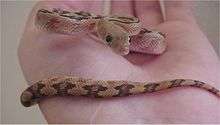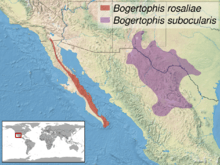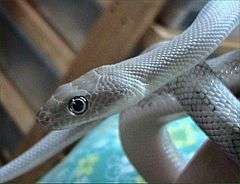Bogertophis
Bogertophis is a genus of New World rat snakes in the family Colubridae. The genus is endemic to the southwestern United States and northern Mexico. There are two accepted species.
| Bogertophis | |
|---|---|
 | |
| Trans-Pecos rat snake Bogertophis subocularis | |
| Scientific classification | |
| Kingdom: | Animalia |
| Phylum: | Chordata |
| Class: | Reptilia |
| Order: | Squamata |
| Suborder: | Serpentes |
| Family: | Colubridae |
| Tribe: | Lampropeltini |
| Genus: | Bogertophis Dowling & R. Price, 1988[1] |
| Species | |
|
Bogertophis rosaliae | |
 | |
Etymology
The genus Bogertophis is named in honor of American herpetologist Charles Mitchill Bogert.[2][3]
Species
The following two species are recognized as being valid.[4]
- Bogertophis rosaliae (Mocquard, 1899) – Baja California rat snake
- Bogertophis subocularis (A. Brown, 1901) – Trans-Pecos rat snake
Nota bene: A binomial authority in parentheses indicates that the species was originally described in a genus other than Bogertophis.
Description
Bogertophis are long, slender snakes, with large eyes that have round pupils. They can attain total lengths (including tail) of 1.68 m (5.5 ft).[5]
B. rosaliae is more variable in color, found in shades of tan, red, orange, or brown.
B. subocularis is almost universally tan in color with interconnected black blotches on the back and two black stripes down the neck. There is an isolated locality of B. subocularis where it is found with a light yellow coloration that is termed a "blonde" variant, and there is also an almost white coloration, that is sometimes referred to as the "silver" variant.

Behavior and diet
Bogertophis are typically nocturnal snakes that feed on a wide variety of rodents, bats and sometimes lizards, especially when younger. They are found in semi-arid habitats; so they spend much of their time hiding from the heat of the day.
Reproduction
Bogertophis species are oviparous.
In captivity
Both Bogertophis species are commonly available in the exotic pet trade. Due to their typically docile nature and reliable feeding habits, they can make an excellent choice for a captive snake. They are also well represented in zoos.
References
- "Bogertophis ". Wikispecies.
- Beltz, Ellin (2006). Scientific and Common Names of the Reptiles and Amphibians of North America – Explained.
- Beolens, Bo; Watkins, Michael; Grayson, Michael (2011). The Eponym Dictionary of Reptiles. Baltimore: Johns Hopkins University Press. xiii + 296 pp. ISBN 978-1-4214-0135-5. (Genus Bogertophis, p. 30).
- "Bogertophis ". The Reptile Database. www.reptile-database.org.
- Powell, Robert; Conant, Roger; Collins, Joseph T (2016). Peterson Field Guide to Reptiles and Amphibians of Eastern and Central North America, Fourth Edition. Boston and New York: Houghton Mifflin Harcourt. xiv + 494 pp. ISBN 978-0-544-12997-9. (Bogertophis subocularis, p. 384 + Plate 35).
Further reading
- Dowling, Herndon G.; Price, Robert M. (1988). "A proposed new genus for Elaphe subocularis and Elaphe rosaliae ". The Snake 20: 52-63. (Bogertophis, new genus).